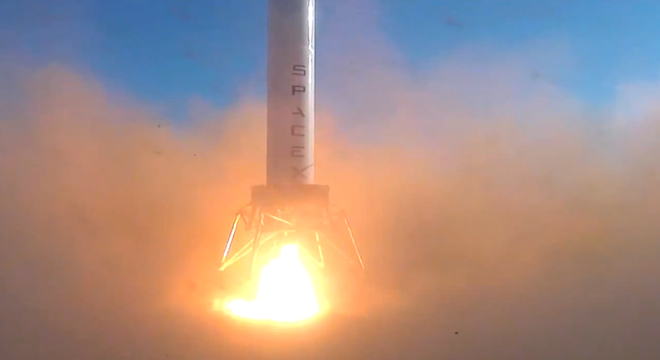SpaceX, the commercial spacefaring company founded by multi-industrialist Elon Musk, isn’t just basking in the success of its historic two missions this year — the first outer space link-up and first cargo transfer by a private company to the International Space Station.
No, the company is also moving onward and quite literally upward with its plans to develop a fully reusable rocketry system, which will drastically reduce the cost of space travel for cargo and crew.
Last week, on November 1, SpaceX’s Grasshopper test rocket performed its second ever test “hop,” launching over two stories up (17.7 feet) and hovering for about eight seconds before successfully landing back down on the company’s launch pad at its test site in McGregor, Texas.
On Saturday, Space founder Elon Musk tweeted a video of the test launch and SpaceX later posted the full video to YouTube on Monday. Watch it below:
The successful second test hop was a drastic leap over the company’s first, which took place in September and during which the Grasshopper only lifted 6 feet into the air. Watch a SpaceX video of that test below:
SpaceX plans to perform increasingly higher “hops” with the Grasshopper over the next three years.
SpaceX’s Grasshopper is a vertical takeoff, vertical landing (VTVL) rocket, made up of one of SpaceX’s Falcon 9 first stage and a Merlin engine, both of which also powered the flights of SpaceX’s Dragon cargo spacecraft to the space station this year.
However, during those flights, the Falcon 9 fist stage separated as planned from the Dragon spacecraft carrying the cargo and fell back to Earth into the Atlantic Ocean. Eventually SpaceX wants to be able to retrieve and reuse the Falcon 9 first stage, but it hasn’t been able to do so yet.
In Grasshopper, SpaceX has reconfigured the Falcon 9 and other components into a 10-story craft with four steel support legs, designed to allow it to take off and land standing straight up.
Getting a reliable reusable spacecraft built and airborne is one of SpaceX’s chief goals, as SpaceX CEO explained in a Google Plus video Hangout ahead of the SpaceX’s Dragon latest flight to the International Space Station in October (relevant portion begins at 22:30).
“Today’s difference, it’s like a thousand times more expensive if not more, to go to space than to take an air trip,” Musk said. “A thousand is a huge difference. Perhaps it can be brought down to being only 10 times more expensive. I think that should be achievable. But that would of course require a two-order of magnitude improvement in space transport…but that needs to happen, and I think it can happen, if we can make rapidly and fully reusable spacecraft and rockets.”
SpaceX is also working on a Falcon Heavy rocket system for carrying twice as much cargo and/or crew as the NASA Space Shuttle was able to, before the fleet’s retirement following a final flight in July 2011.
SpaceX’s ultimate goal is to become the de-facto mode of transportation for NASA astronauts and other commercial satellites and equipment into space and is well on its way to doing so, completing not only the first two flights to the International Space Station earlier this year but also passing the first two of three phases in commercial space crew craft review requirements with NASA in late October. The company already has a $1.6 billion deal with NASA to fly 12 cargo missions to the International Space Station over the coming years.






